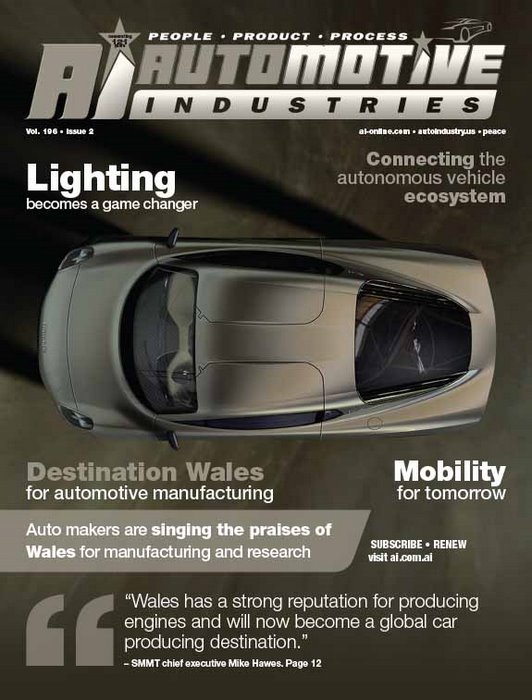
Automotive investors are singing the praises of Wales as a destination for new and expanded plants.
According to the Society of Motor Manufacturers and Traders (SMMT) Wales has become an increasingly attractive place for investors thanks to its established automotive supply chain sector and attractive incentives. “Wales has a strong reputation for producing engines and will now become a global car producing destination. We’ve already seen the ability of automotive manufacturing to revitalise communities across the UK, particularly in the Midlands and North West, where billions of pounds of investment has helped secure jobs for tens of thousands of people,” said SMMT chief executive Mike Hawes in his comment on the growth in the Welsh automotive sector.
With the formal process of BREXIT underway, the European automotive industry is hoping that there will be an agreed zero tariff to enable the free flow of vehicles across borders. For UK vehicle manufacturers, the challenge is now even greater than before to source more componentry from companies based in the UK to sustain competitiveness.
In 2016 Toyota, Aston Martin and reborn British sports car maker TVR all announced major investments in Wales. There are currently more than 150 automotive component and system companies based in the country, employing 19,000 people and generating £3.6 billion (US$4.5 bn) for the economy.
In February 2017 Toyota Manufacturing UK (TMUK) announced that it is to build its next-generation hybrid engines at its Deeside plant in North Wales in a £7m investment supported by the Welsh Government. The new engine is the latest generation of Toyota’s hybrid powertrain technology, and will play an important role in Toyota Motor Europe’s ambitions for increasing hybrid vehicle sales.
Wales already has a strong engine manufacturing presence, with Ford and Toyota plants in the country accounting for a third of all engines built in the United Kingdom in 2016. Welsh plants were also responsible for producing two out of every five (41.3%) of engines exported from the UK during this period.
The new Toyota plant will be built alongside the current production line for petrol and hybrid petrol units for the Auris range, which is assembled by TMUK at Burnaston in Derbyshire. Engines are also exported from the plant to other Toyota manufacturing centers in Europe, South America, South Africa and Japan. The 1.8 liter hybrid engines are bound for Turkey, where the crossover Toyota C-HR is being built. The investment by Toyota Motor Europe in Deeside will be supported by £700,000 from the Welsh Government. The decision reinforces TMUK Deeside’s reputation for superior quality and productivity and helps secure around 130 existing jobs at the plant.
Jim Crosbie, Engine Plant Director, said in a media release: “Toyota has a long and successful record of building engines in North Wales. This announcement is a big vote of confidence in the high skills, quality of work and commitment of our workforce.” Dr Johan van Zyl, Toyota Motor Europe President adds “the crossover market has been booming and will continue to grow in Europe and elsewhere. We are entering the C-segment crossover market with a fantastic new product with a hybrid powertrain from the start. It will provide our European operations with further perspectives for sustainable growth.”
Aston Martin
Wales hit the first note in a field of 20 locations worldwide for the manufacture of the new Aston Martin DBX 4X4. The marque’s latest model will start to roll off a £200 million production line in St Athan, South Wales, from 2019. A new facility is needed because Aston’s plant at Gaydon in Warwickshire is planned for full capacity.
In early 2015 a management team headed up by Andy Palmer, President and Chief Executive of the luxury sports car maker and Chief Marketing Officer Simon Sproule set out on a scouting mission. “SUVs (Sports Utility Vehicles) are a new and interesting market, which has become increasingly important,” said Sproule “It’s what people want to drive and we decided this was a segment we want to be active in.”
Commenting on the decision to site the new plant in Wales, Sproule says “as a location to make a fast start to do industrial style activities, the infrastructure is all there. There is also a pool of high quality labor in the South Wales area and a government that is actively involved in attracting inward investment.” The team from the luxury brand explored 20 potential locations around the world, mainly in North America, Eastern Europe and the UK. From the start of the process, St Athan was one of the frontrunners. “It was very impressive,” Sproule says of the Welsh site. “It was a hard fight and eventually St Athan prevailed.”
The 90-acre site at St Athan has all the space the car manufacturer requires – there are three well-built and maintained aircraft hangars to house production. It has office buildings and
Com the infrastructure needed for manufacturing projects, with parking for more than 600 employees.
TVR
Niche sports car company TVR proclaims that it is “roaring back” into the market with its new plant in Wales. In March 2016 it was announced that TVR would be setting up production in the Ebbw Vale Enterprise Zone in South Wales. The Welsh Government is also investing in the car maker, which plans to invest over £30 million in plant and equipment over a five year period.
The chassis and body has been designed by Gordon Murray, and will be the first production car to be manufactured using his company’s iStream® assembly process. Power is provided by a Cosworth tuned and enhanced V8 engine. The Welsh factory will be busy fulfilling orders that already run through to the end of 2018.
TVR is taking orders for its new model.
New technology
Wales is also gaining a foothold in developing new technologies. Riversimple, a small innovative company based in the heart of Wales has developed a zero-emission hydrogen fuel powered two seater car. The disruptive technology company was awarded the RAC Simms Medal for an Outstanding Contribution to Motoring Innovation for its Rasa hydrogen fuel cell car, which is currently believed to be the greenest car on the road for ordinary road use and emits just water. Currently undergoing extensive testing, the car is due to be launched in 2018.
In addition the University of South Wales – one of eight universities in Wales – the Centre for Automotive and Power Systems Engineering (CAPSE) is supporting a number of leading automotive OEMs to develop low carbon automotive technology for both in both passenger vehicles and motorsport














More Stories
New generation of Donaldson compressed air dryer systems offers enhanced reliability and energy efficiency
Lakshmi Prasad Bhatta on the quest for zero road deaths
Cybord TCI – The Future of Manufacturing Integrity